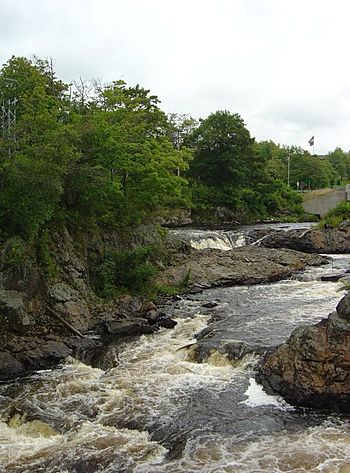Machias River facts for kids
Quick facts for kids Machias River |
|
|---|---|

Bad Little Falls
|
|
| Country | United States |
| Physical characteristics | |
| Main source | Western Washington County, Maine 1,371 feet (418 m) |
| River mouth | Machias Bay 0 feet (0 m) |
| Length | 60 miles (97 km) |
| Basin features | |
| Basin size | 498.3 square miles (1,291 km2) |
The Machias River is a river about 60 miles (97 kilometers) long in Maine, USA. It flows through Washington County, which is in the eastern part of Maine. The river starts at Fifth Machias Lake and flows past the town of Machias. Finally, it empties into Machias Bay.
History of the Machias River
The name "Machias" probably comes from a word used by the Passamaquoddy people. They are a Native American tribe from this area. The word means "bad run of water" or "bad little falls." This name makes sense because some parts of the river have rapids that are hard to canoe through.
Native Americans used the Machias River as a route for seasonal travel. The first European settlement here was likely an English trading post in 1633. However, the French quickly destroyed it.
The first lasting settlement in the area began in 1763. Its main goal was to produce lumber. In 1764, they produced 1.6 million board feet of lumber. A "board foot" is a way to measure wood.
The mouth of the river and nearby waters were important during the American Revolution. This is where the Battle of Machias took place. It was the very first naval battle of the American Revolution. The British needed lumber for their forces in Boston, which led to this battle.
Lumber remained a major industry along the river for many years. The river's strong current helped power the sawmills. At its peak, the area produced as much as 40 million feet of lumber in one year. Later, in the late 1800s, production dropped to between 10 and 20 million feet per year.
The first trees cut were mostly pine. Later, people also cut hemlock and spruce trees. The river's natural water flow changes with the seasons. So, dams were built to make sure the mills always had enough power. The last dam on the river was broken in 1973 and completely removed in 2000.

